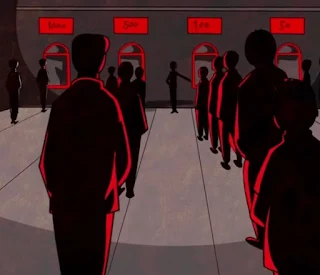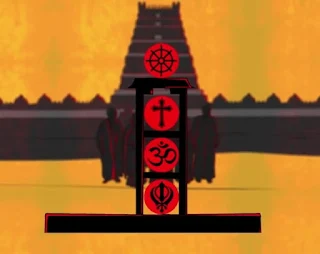Hindu temples do not belong to Hindus. I am not being rhetorical here. This is a statement of fact. Hindu temples have been usurped by the very institution that is duty-bound to protect the freedom of religion... The Indian state.

In states like Tamil Nadu, for every 100 rupees that you donate to a temple under state control, which is almost every temple, 18 rupees land in the coffers of the government.
Effectively, Hindu pay a religious tax, a kind of Jizya, for donating money to religious causes dear to them. Remember that the next time you visit a temple. However, that's not all. Bear with me a few minutes more.
The story of the government takeover of temples began in 1925, when the British government passed a legislation that allowed them to interfere in the running of Hindu temples in the Madras Presidency, which included all of the present-day Tamil Nadu and Andhra Pradesh and large parts of current day Karnataka, Kerala and Odisha.
But why 1925?
With the active support of missionaries, the so called self-respect movement in South India had gathered momentum in the decade preceding this legislation.
As part of this movement the Aryan Invasion Theory had gained significant traction thanks not only to the British but also the proponents of the so-called Dravidian movement who used this rather wishful theory to vilify all institutions associated with Brahmins, who they imagined to be the descendants of the Aryan invaders.
Notwithstanding the completely unscientific basis of their politics, the ideologues of this movement held a great sway in the political climate of the era and in their endeavour to deprive the Brahmins of the power they allegedly held, namely that of running the affairs of the temples, these social justice warriors of the day ended up destroying the livelihoods of several other groups within the Hindu fold, which had a specific function and a specific place in the temple ecosystem which consisted of pahalwans, flower sellers, sculptors, performing artists and so on and so forth. But the real damage was yet to begin and ironically, it happened not under the colonial rule but when India became a free country.
In 1951, the Shirur Mutt in Udipi, along with two other major temples, was notified for takeover by the state under the Madras Hindu religious endowments act of 1927, which was then replaced by the madras hindu religious and charitable endowments Act of 1951.
This led to a legal battle in the Madras High Court and eventually in the Supreme Court of India which in 1954 struck down some of the central provisions of the legislation as unconstitutional and illegal.
But in 1959, a new legislation was brought in by the state government which effectively rehashed the very same provisions that were struck down five years earlier by the highest court of the land.
This legislation is in force even today and remained unchallenged right until the late pujya Swami Dayananda Saraswati ji stepped in, in the year 2012, to challenge the Hindu religious and charitable endowment legislations of Tamil Nadu, Andhra Pradesh and Puducherry.
What is important to note is that the presence of such Hindu centric legislations is not limited only to the southern states. Bihar, Himachal Pradesh, Uttar Pradesh, Odisha and Maharashtra too have legislations which control Hindu temples.
Despite this, prior to Swami Dayananda Saraswathi, barring an exception here or there, no one from the Hindu society deemed it fit to challenge this blatant takeover of their religious institutions by the state, which is a violation of their fundamental rights.
The legendary apathy of the modern Hindu was on glorious display. Since 2012, the petition filed by Swamiji has been languishing in the Supreme Court and the court hasn't had the time to look at it while it seems to have had all the time in the world to take up cases like Triple Talaq.
As a result, over 34,000 temples just in the state of Tamil Nadu, are in a limbo and devotees are waiting for justice to be delivered some day.
But why is the issue important?
Why should the Supreme Court take it up with more alacrity than it has so far?
- Point number one - State control of temples encourages corruption. In 2017, the Madras High Court delivered a judgement, which was a scathing indictment of the manner in which the Tamilnadu HRCE Department and State Police officials were hand in glove with thieves of temple heritage and jewels. This was not a one of instance and such horrendous examples abound, where the meddling by the government in temple affairs leads to huge and monumental corruption.
- Point number two - State control of temples is inherently discriminatory. India is a secular country, which implies that the state is equally distant from all religions. However, by interfering exclusively in Hindu temples, and not in the places of worship of other communities, the state becomes explicitly anti Hindu in its orientation
- Point number three - State control of temples weakens Hindus collectively. The Devaswom Minister of Kerala took a lead role in the beef festival and is presiding over the institutions of that state. It was recently found that close to 40 employees of the Tirupati Devasthanam are non Hindus, including the top executive, who's a Christian. It is inconceivable as to why matters of a certain faith would be allowed to be managed by those who profess a different faith. Also, which non-Hindu religious institution permits a Hindu to preside over its affairs?
- Point number four - State control of temples facilitates conversion. Because of the infiltration of the temple management by non-Hindus the traditional eco system consisting of various castes and communities has broken down and the people specializing in certain roles such as sculptors have suffered financially and have thus been made more vulnerable to predatory proselytization.
- Point number five - Temples lose real estate under state control. Almost every other week, a case of temple land being taken over for other purposes, including hostile takeover by other religious groups, is reported in local media all over the country but never acquires the dimensions of national news. From 1959, at least forty seven thousand acres of temple land have been alienated from temples of Tamil Nadu alone, without so much as a whimper from anyone.
- Point number six - State control of temples brings a bad name to Hindus. Many of the temple practices that embarrass well-meaning Hindus like darshan queues based on payment, are practices introduced and actively sustained by the government without the consent of the community... and Hindus take the blame for it.
By imposing itself on the day-to-day functioning of temples the state has ended up smothering the cultural life of India and thus has alienated Indians from their own roots.
Temples have been made subservient to the State on the pretext of corruption in the traditional management structures consisting of members of local Hindu communities. While one may grant the benefit of the doubt to the state's intentions, it is pertinent to ask the following questions. Once the state has set the house in order,
What prevents it from exiting?
What is the reasonable duration for which the state may be temporarily allowed to take over the management of a given temple?
Most importantly, is corruption limited only to Hindu institutions?
After all, the Church owns vast tracts of prime agricultural land in India and corruption in its dealings is not unheard of.
Why then are temples singled out in such a shameless manner?
The temple happens to be the first choice for an average Hindu in spiritual and religious matters. The temple is the nerve center of the Hindu society and identity, whether it is in terms of upliftment of the poor, education, culture, arts or plain community strengthening. By taking over temples the state has paralysed the Hindu society.
Temples in the long run will play a pivotal role in forging a sense of civilizational unity. All the resources required for a cultural resurgence of Bhaarat lie with the temples. And the temple in turn is in the hands of the state. The state needs to exit now.











